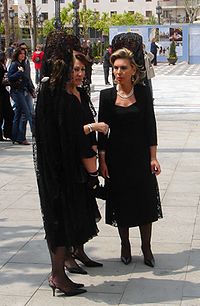- Mantilla
-
A mantilla is a lace or silk veil or shawl worn over the head and shoulders, often over a high comb, popular with women in Spain.[1] It is particularly associated with traditional devotional practices among women in Catholicism.[2]
Contents
History
The lightweight ornamental mantilla came into use in the warmer regions of Spain towards the end of the sixteenth century, and ones made of lace became popular with women in the 17th and 18th centuries being depicted most notably in the portraits of Diego Velázquez and Goya. In the nineteenth century, Queen Isabel II (1833–1868) actively encouraged its use. The practice diminished after her death, and by 1900 the use of the mantilla became largely limited to special ceremonies, such as bullfights, Holy Week and weddings.
Peineta
A peineta similar in appearance to a large comb is used to hold up a mantilla. This ornamental comb, usually in tortoiseshell color, originated in the 19th century. It consists of a convex body and a set of prongs and is often used in conjunction with the mantilla. It adds the illusion of extra height to the wearer and also holds the hair in place when worn during weddings, processions and dance. It is a consistent element of some regional costumes of Valencia and Andalusia and it is also often found in costumes used in the Moorish and Gypsy influenced music and dance called Flamenco.
Usage in Catholicism
In the Catholic Church, the older practice had been for women to wear hats, chapel veils, or mantillas to church. The requirement of head covering for women is based in 1 Corinthians 11. Because of a misunderstanding in Can. 6 §1 of the 1983 Code of Canon Law, many have assumed that the earlier injunction was abrogated. Because the practice of veiling is not mentioned in the newer canon law, however, the earlier injunction remains technically in effect in accordance with Can. 21: "In a case of doubt, the revocation of a pre-existing law is not presumed, but later laws must be related to the earlier ones and, insofar as possible, must be harmonized with them." The practice has declined since the Second Vatican Ecumenical Council, though some Catholic women continue to use them, especially[2] since Pope Benedict XVI's motu proprio Summorum Pontificum.
Perhaps[weasel words] due to the promotion of the mantilla by Queen Isabella II, it became traditional for ladies to wear a mantilla when received in audience by the Pope, though other head coverings for women prevailed before it and after it. In the second half of the twentieth century its use declined markedly, though it is not completely out of use.
Irish presidents Mary Robinson and Mary McAleese, Soviet Union First Lady Raisa Gorbachev, and German Chancellor Angela Merkel all met popes without wearing mantillas.
Queen Sofía of Spain, as a Catholic Queen, exercised a royal privilege known as Privilège du blanc, an entitlement and royal privilege to wear white attire instead of black in the presence of the Pope. Only Roman Catholic queens and kings are allowed to have an audience with the Pope wearing white clothing, while the rest are advised and expected to wear black.[citation needed] At the inauguration of Pope Benedict XVI and the requiem mass for John Paul II, Queen Sofía wore a white mantilla while Queen Paola of Belgium wore a black one.
Mantillas were worn by Laura Bush while visiting the Holy See in 2006; members of Grand Ducal Family of Luxembourg during inauguration festivities; and Michelle Obama while visiting the Holy See in July 2009.
In popular culture
The mantilla is sometimes seen on television programmes. In the British television soap Hollyoaks, Catholic character Carmel Valentine wore a mantilla while in mourning for her deceased sister, Tina Reilly. Mimi Maguire from Channel 4 drama-comedy, Shameless, also wore one. Lady Gaga wore a mantilla in the video for her song, Alejandro.
See also
References
- ^ The American Heritage Dictionary of the English Language: Fourth Edition. 2000
- ^ a b "Will You Mantilla With Me? www.mantillawithme.com". http://www.mantillawithme.com/. Retrieved 2010-04-26.
External links
Categories:- Spanish clothing
- Hats
- Christianity and women
Wikimedia Foundation. 2010.


